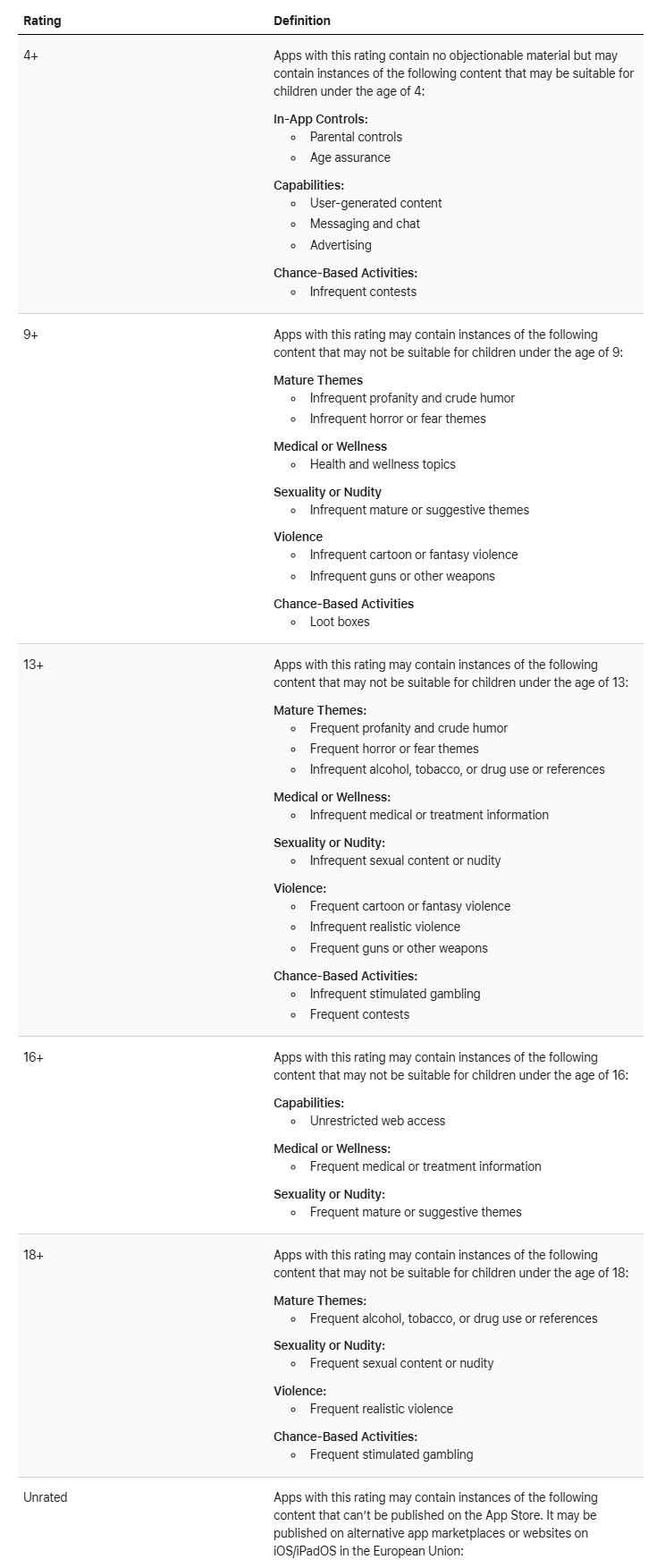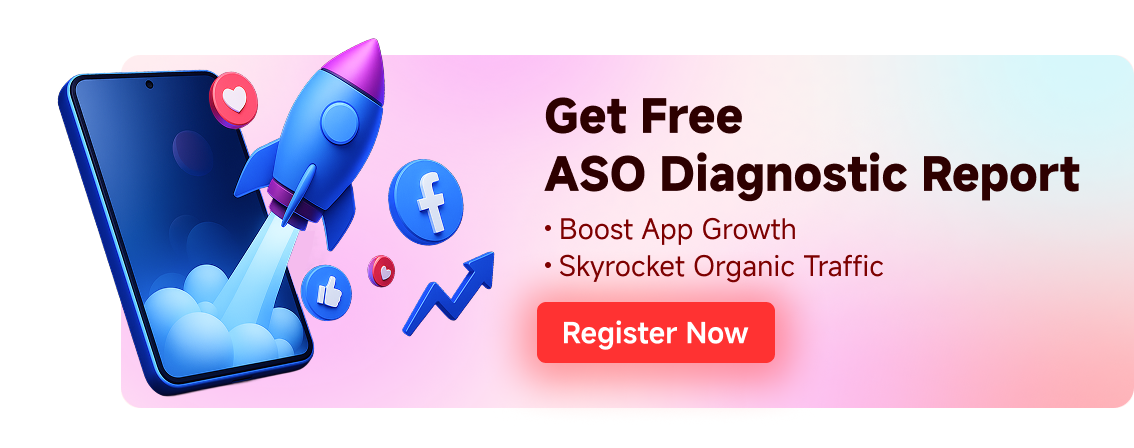
Loading...
Free consultation with ASO specialists
Doing ASO for the first time or have no idea how to carry out targeted optimization of your app?
We offer one-on-one customized services provided by app marketing specialists
Apple's App Store Ratings and Reviews Update, Outdated Apps Can't Be Updated
2025-08-04
Abstract: Apple on July 24, 2025Update App Store Connect Ratings and Reviews Policy, introduced three new standards 13+, 16+, and 18+ to replace the original classification. Global developers must complete the submission of the new questionnaire before January 31, 2026; otherwise, their application update permissions will be frozen. This reform directly affects app store exposure strategies and compliance costs.
Policy Core Changes: Refined Grading and Global Regulatory Adaptation
Apple's age rating system has been restructured from the original four levels to five: 4+, 9+, 13+, 16+ and 18+. The core changes are reflected in three dimensions:

-
The compliance significance of adding a grading level
13+ ratings are for content with mild fantasy violence or medical information scenes; 16+ ratings are for content with frequent mature themes or strong language; 18+ ratings cover adult content such as gambling and real-life violence. The new rating design aims to bridge regulatory differences between the EU, North America, and Asia-Pacific regions, such as South Korea's special restrictions on 16+ content under the Youth Protection Act.
-
Eliminating the old standard of operation
The existing 12+ and 17+ ratings will be completely phased out. Developers should note that some original 12+ apps may be reclassified to 13+, resulting in a narrower user coverage, while 17+ apps involving gambling mechanisms will be forcibly upgraded to 18+.
-
Regional Differentiation Implementation Mechanism
Apple will implement localised ratings rules in markets such as Brazil and Australia. For example, content rated M (15+) by the Australian Classification Board (ACB) will need to be mapped to the 16+ level for display in the new system.
Re-assessment Process for Applications: Automated Migration and Manual Intervention
Apple has completed the automatic grading migration based on historical data, but developers still need to actively participate in the following key processes:
-
Ratings and Reviews
After logging in to App Store Connect, developers can view the system's assignment results in the "Age Ratings" module. If there is any objection to the automatic rating, a request for manual review must be submitted before submitting the new questionnaire, and content proof materials must be prepared.
-
Analysis of the mandatory fields in the new questionnaire
The questionnaire is designed around four risk dimensions, each of which affects the final rating:
-
In-app control mechanism: Detailed explanation of the paywall design, unlocking mechanism and parental control function implementation is required
-
Feature Specification: Must disclose user-generated content (UGC) review mechanism, real-time positioning function, and stranger social scene
-
Healthcare Content: Modules involving symptom diagnosis, treatment advice or health data processing need to provide proof of medical qualifications
-
Sensitive Content Ratings: Require quantifying the frequency of violent and terroristic elements, and explain the filtering scheme for AI-generated content
-
Special compliance requirements for AI content
Apple emphasized in the policy appendix that applications with chatbots or generative AI functions must declare their content security protocols. Developers need to provide technical documentation on training data screening records and real-time filtering mechanisms.
Technology Implementation and User Impact
The new rating system has been deployed in the next generation of operating system beta, and the specific implementation path is as follows:
-
Platform Support Timetable
The new rating logic has been integrated into the iOS 26, iPadOS 26, macOS Tahoe 26, tvOS 26, visionOS 26 and watchOS 26 developer beta. The final version will be released to the public in September 2025, when the store will enable the following new features:
-
The application details page displays dynamic grading icons (such as 16+ red triangle identification)
-
Family Sharing devices automatically hide apps that are over age.
-
Apps with UGC features add "User Content Not Verified"提示
-
Impact of Rating Changes
The application of rating upgrades will face two major risks: a decrease in the recommendation weight of the "Children and Families" category, and automatic blocking of devices for users aged 12-15. Data shows that after entertainment applications are upgraded from 12+ to 13+, the average coverage of target users decreases by 7.3% (based on Apple's 2024 rating test data).
Developer Compliance Time Window and Enforcement Actions
Apple's phased transition schedule includes hard requirements that cannot be extended:
-
Final deadline January 31, 2026
Developers who do not submit the questionnaire by the deadline will trigger App Store Connect feature restrictions:
-
Unable to submit new app binary
-
Existing app metadata (description/screenshots/keywords) update permissions are frozen
-
Price adjustment and promotional activity application functions disabled
-
Continued Risk of Rating Mismatch
Even if the questionnaire has been submitted, if the actual content does not match the declaration, it may lead to:
-
App has been force re-rated (no appeal buffer)
-
Severe violators receive ASM-10534 compliance warning
-
Account review triggered by three violations
Developer Response to Roadmap Suggestion
Based on Apple's policy documents and compliance practices, it is recommended to proceed in three stages:
Phase 1: Current Status Audit (July-August 2025)
-
Export the current auto-ratings report from App Store Connect
-
Set up a cross-departmental working group (development/legal/product)
-
Key screening UGC module, AI dialogue system, and in-app purchase design
-
Establish a mapping matrix between content elements and grading standards
Phase 2: Questionnaire filling (September-December 2025)
-
Prepare the evidence package according to four dimensions:
-
Features: Provide social function architecture diagram and audit log sample
-
Medical Content: Upload medical qualification certificates or disclaimer text
-
Sensitive content: Compile a frequency statistics table of the content (such as the duration of violent scenes per minute)
-
-
Local compliance checks must be performed for multi-region applications:
-
EU market reference to GDPR Article 8 age verification requirements
-
Korea market needs to match Article 9 of the Youth Protection Act
-
Phase 3: Tiered Optimization (January 2026)
-
Dynamically adjust content with the Age Rating Declaration API
-
Deploying age group A/B testing in TestFlight
-
Prepare the appeal package for rating objections (including content screenshots and filtering mechanism description)
Compliance Insights under Global Regulatory Trends
This reform reflects the triple regulatory upgrade of the mobile ecosystem:
-
Deepening of regulatory coordination in Europe and America
Article 5(9) of the EU DMA requires platforms to strengthen child protection, and the U.S. FTC is advancing the Children's Privacy Protection Enhancement Act. The two countries' regulatory agencies have established a mechanism for mutual recognition of ratings and reviews.
-
Balancing Privacy Protection and Technology Compliance
Apple explicitly rejects mandatory age verification solutions in its developer documentation: Implementing a privacy-first compliance path through the Declared Range API, avoiding the collection of sensitive information such as government IDs.
-
Developer Responsibility Boundary Expansion
The new policy will include AI-generated content in the regulatory scope and require the establishment of a full-link content filtering system. AI applications that do not deploy real-time content monitoring will face higher risk ratings at the questionnaire submission stage.
Compliance Warning:
There are only 6 months left until the deadline of January 31, 2026. However, the compliance cycle for leading developers usually takes 4-5 months (including legal review and localization adaptation). It is recommended to immediately initiate the following high-priority actions:
-
Log in to App Store Connect to confirm the automatic ratings status
-
Download the new version of the questionnaire template to pre-fill key modules
-
Key review of applications with AI dialogue, social functions or in-app purchase systems
Apple's policy document clearly states that violations of the rating system will directly affect the visibility of the App Store, and there is no grace period.
Facing the complex policy environment, developers can use AppFast's professional metadata diagnostic tool to quickly identify potential risks on the store page and generate optimization suggestions. Click Diagnose Now, one-click to improve application compliance and exposure rate, and calmly cope with the policy challenges of app stores.
Related recommendations

